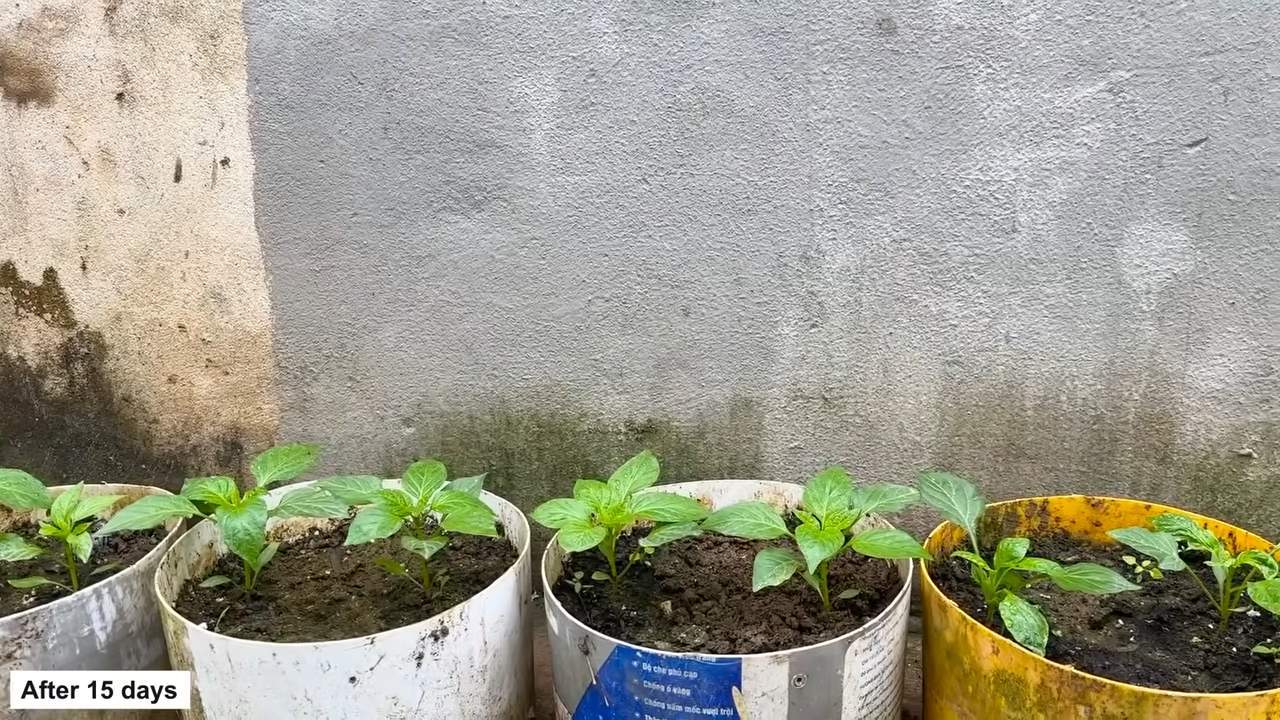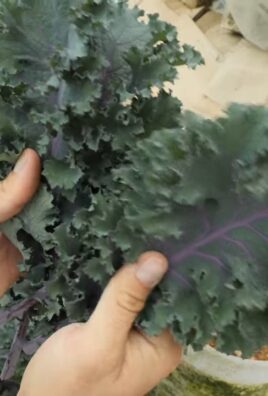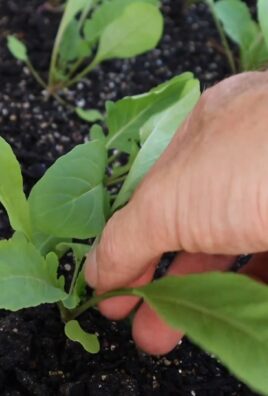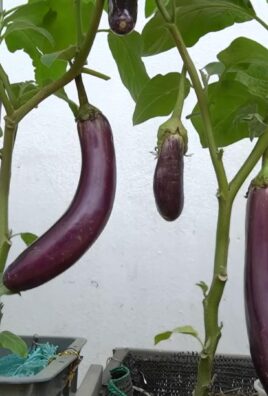Growing bell peppers in pots can be incredibly rewarding, and I’m here to tell you it’s easier than you might think! Imagine stepping outside your door and harvesting vibrant, juicy bell peppers, ready to add a burst of flavor to your next meal. Forget those bland, store-bought peppers; with a little know-how, you can cultivate your own delicious crop right on your patio or balcony.
For centuries, container gardening has allowed people to bring the bounty of the earth to even the smallest of spaces. From the hanging gardens of Babylon to the window boxes of modern city dwellers, the desire to nurture plants in pots is deeply ingrained in our history. But let’s face it, sometimes it feels like a secret art! That’s why I’m so excited to share these simple, yet effective, DIY tricks and hacks that will transform you into a bell pepper-growing pro.
Why is this so important? Well, not everyone has access to a sprawling garden, and even if you do, sometimes the conditions aren’t ideal for these sun-loving beauties. Plus, growing bell peppers in pots gives you complete control over the soil, watering, and sunlight, leading to healthier plants and a more abundant harvest. So, if you’re ready to unlock the secrets to growing your own delicious bell peppers, keep reading! I’m going to show you everything you need to know, from choosing the right pot and soil to preventing common problems and maximizing your yield. Let’s get started!

Growing Bell Peppers in Pots: A Beginner’s Guide
Hey there, fellow gardening enthusiasts! I’m so excited to share my experience growing bell peppers in pots. It’s surprisingly easy, even if you don’t have a huge garden. I’ve had some amazing harvests using this method, and I’m confident you can too. Let’s dive in!
Choosing the Right Bell Pepper Variety
First things first, you need to pick the right bell pepper variety. Not all peppers are created equal, especially when it comes to container gardening. Some grow much larger than others and might not thrive in a pot. Here are a few of my favorites that do exceptionally well in containers:
* ‘Patio Bell’: As the name suggests, this variety is specifically bred for containers. It’s compact and produces a good yield of medium-sized peppers.
* ‘Mini Bell’: These are adorable and perfect for snacking! They’re also relatively small plants, making them ideal for smaller pots.
* ‘Sweet Banana’: While technically not a bell pepper, these sweet, yellow peppers are easy to grow and produce prolifically in pots. They add a lovely splash of color to your patio too!
* ‘California Wonder’: This is a classic bell pepper variety that can be grown in pots, but make sure you choose a larger container to accommodate its size.
Gathering Your Supplies
Before you start planting, let’s make sure you have everything you need. This will save you time and frustration later on. Here’s my go-to list:
* Bell pepper seeds or seedlings: You can start from seeds indoors or buy seedlings from a local nursery. Seedlings are a quicker option, especially if you’re a beginner.
* Pots: Choose pots that are at least 12 inches in diameter and depth. Larger pots (14-16 inches) are even better, especially for larger varieties like ‘California Wonder’. Make sure the pots have drainage holes!
* Potting mix: Use a high-quality potting mix specifically formulated for containers. Avoid using garden soil, as it can compact and doesn’t drain well in pots.
* Slow-release fertilizer: This will provide your pepper plants with a steady supply of nutrients throughout the growing season.
* Watering can or hose: You’ll need a way to water your plants regularly.
* Plant labels: Labeling your plants will help you keep track of which variety is which.
* Optional:
* Stakes or cages: These can help support your pepper plants as they grow, especially if they become heavy with fruit.
* Mulch: A layer of mulch can help retain moisture and suppress weeds.
Planting Your Bell Peppers
Okay, now for the fun part – planting! Whether you’re starting from seeds or using seedlings, the process is pretty straightforward.
Starting from Seeds (Optional)
If you’re starting from seeds, you’ll need to start them indoors about 6-8 weeks before the last expected frost.
1. Fill seed trays or small pots with seed-starting mix. Moisten the mix thoroughly.
2. Sow the seeds about ¼ inch deep. I usually plant 2-3 seeds per cell or pot to increase my chances of germination.
3. Cover the seeds with a thin layer of seed-starting mix.
4. Water gently.
5. Place the seed trays or pots in a warm location. A heat mat can help speed up germination.
6. Keep the soil consistently moist but not soggy.
7. Once the seedlings emerge (usually within 7-14 days), move them to a sunny location or under grow lights.
8. Thin the seedlings to one per cell or pot once they have a few sets of true leaves.
9. Harden off the seedlings before transplanting them outdoors. This involves gradually exposing them to outdoor conditions over a period of 1-2 weeks. Start by placing them outside for a few hours each day, gradually increasing the amount of time they spend outdoors.
Transplanting Seedlings
If you’re using seedlings from a nursery, you can skip the seed-starting process and go straight to transplanting.
1. Fill your pots with potting mix, leaving a few inches of space at the top.
2. Gently remove the seedlings from their containers. Be careful not to damage the roots.
3. Loosen the roots slightly. This will encourage them to spread out and establish themselves in the new pot.
4. Plant the seedlings in the center of the pots. The top of the root ball should be level with the soil surface.
5. Backfill with potting mix and gently firm the soil around the seedlings.
6. Water thoroughly.
7. Add a layer of mulch around the base of the plants. This will help retain moisture and suppress weeds.
8. If using stakes or cages, install them now. This will provide support for the plants as they grow.
Caring for Your Bell Pepper Plants
Now that your bell pepper plants are in their pots, it’s time to give them the care they need to thrive. Here’s what you need to know:
Sunlight
Bell peppers need at least 6-8 hours of sunlight per day. Choose a sunny location for your pots. If you don’t have a spot that gets full sun, you can supplement with grow lights.
Watering
Water your bell pepper plants regularly, especially during hot, dry weather. The soil should be consistently moist but not soggy. Check the soil moisture by sticking your finger into the soil. If the top inch feels dry, it’s time to water. Avoid overwatering, as this can lead to root rot.
Fertilizing
Bell peppers are heavy feeders, so they need regular fertilization. Use a slow-release fertilizer at planting time, and then supplement with a liquid fertilizer every 2-3 weeks. Choose a fertilizer that is specifically formulated for vegetables. I like to use a balanced fertilizer with an NPK ratio of 10-10-10 or 14-14-14.
Pruning
Pruning isn’t strictly necessary, but it can help improve air circulation and encourage fruit production. Remove any suckers (small shoots that grow from the base of the plant) and any yellowing or diseased leaves. You can also pinch off the tips of the branches to encourage bushier growth.
Pest and Disease Control
Bell peppers can be susceptible to a few pests and diseases. Keep an eye out for aphids, whiteflies, and spider mites. You can control these pests with insecticidal soap or neem oil. Common diseases include blossom end rot and fungal diseases. Blossom end rot is caused by a calcium deficiency, so make sure your soil is rich in calcium. Fungal diseases can be prevented by providing good air circulation and avoiding overwatering. If you notice any signs of disease, treat the plants with a fungicide.
Harvesting Your Bell Peppers
The moment you’ve been waiting for – harvesting! Bell peppers are typically ready to harvest about 60-80 days after transplanting, depending on the variety.
1. Look for peppers that are firm, glossy, and have reached their mature color. The color will vary depending on the variety.
2. Use a sharp knife or pruning shears to cut the peppers from the plant. Leave a small stem attached to the pepper.
3. Harvest regularly to encourage the plant to produce more peppers.
Troubleshooting
Even with the best care, you might encounter some problems along the way. Here are a few common issues and how to fix them:
* Blossom end rot: This is caused by a calcium deficiency. Add calcium to the soil by amending with bone meal or using a calcium-rich fertilizer.
* Yellowing leaves: This can be caused by a nutrient deficiency, overwatering, or underwatering. Check the soil moisture and fertilize if necessary.
* Pests: Control pests with insecticidal soap or neem oil.
* Lack of fruit: This can be caused by a lack of pollination, insufficient sunlight, or nutrient deficiencies. Make sure your plants are getting enough sunlight and fertilizer. You can also try hand-pollinating the flowers by gently shaking the plant or using a small brush to transfer pollen from one flower to another.
Enjoying Your Harvest
Congratulations! You’ve successfully grown bell peppers in pots. Now it’s time to enjoy the fruits (or rather, vegetables) of your labor. Bell peppers are delicious raw, cooked, or stuffed. They’re a great addition to salads, stir-fries, and omelets. You can also roast them, grill them, or pickle them. The possibilities are endless! I love using my homegrown bell peppers in my homemade salsa and stuffed pepper recipes.
Growing bell peppers in pots is a rewarding experience. With a little bit of care and attention, you can enjoy a bountiful harvest of fresh

Conclusion
So, there you have it! Growing bell peppers in pots isn’t just a possibility; it’s a rewarding and surprisingly simple way to bring fresh, vibrant flavor right to your doorstep. We’ve explored the key steps, from selecting the right pot size and soil mix to providing adequate sunlight and consistent watering. But why is this DIY trick a must-try?
Firstly, the convenience is unparalleled. Whether you have a sprawling garden or a tiny balcony, container gardening allows you to cultivate bell peppers regardless of your space limitations. Imagine stepping outside and harvesting a perfectly ripe bell pepper for your salad or stir-fry – the freshness and flavor are simply unmatched.
Secondly, you have complete control over the growing environment. You can easily move your pots to chase the sun, protect them from unexpected frosts, or shield them from excessive rain. This level of control translates to healthier plants and a more abundant harvest. Plus, container gardening minimizes the risk of soilborne diseases and pests that can plague in-ground gardens.
Thirdly, it’s incredibly satisfying! There’s something deeply fulfilling about nurturing a plant from seedling to harvest. Watching your bell peppers grow and ripen is a testament to your efforts and a tangible reward for your care.
But the fun doesn’t stop there! Feel free to experiment with different varieties of bell peppers. Try growing colorful bell peppers like purple, yellow, or orange alongside the classic green. You can also explore different pot sizes and materials to find what works best for your space and aesthetic. Consider adding companion plants like basil or marigolds to your pots to deter pests and attract pollinators.
Don’t be afraid to get creative with your soil mix. Adding compost or other organic matter will provide your bell peppers with the nutrients they need to thrive. You can also experiment with different fertilizers to see which ones produce the best results.
Growing bell peppers in pots is an adventure, and we encourage you to embark on it! It’s a fantastic way to connect with nature, enjoy fresh produce, and add a touch of beauty to your surroundings.
We’re confident that you’ll find this DIY trick to be both enjoyable and rewarding. So, grab your pots, soil, and bell pepper seedlings, and get started today!
And most importantly, we want to hear about your experience! Share your tips, tricks, and photos with us in the comments below. Let’s create a community of bell pepper enthusiasts and learn from each other’s successes and challenges. Happy gardening!
Frequently Asked Questions (FAQ)
What is the best pot size for growing bell peppers?
The ideal pot size for growing bell peppers is at least 12 inches in diameter and 12 inches deep, but larger is generally better. A 5-gallon pot is a good starting point, but a 10-gallon pot will provide even more room for the roots to grow and will help retain moisture. The larger the pot, the less frequently you’ll need to water. If you’re planning to grow multiple bell pepper plants in the same pot, choose a pot that is large enough to accommodate all of them comfortably, with at least 12 inches of space between each plant.
What kind of soil should I use for growing bell peppers in pots?
Bell peppers need well-draining soil that is rich in organic matter. A good potting mix will typically contain a blend of peat moss, perlite, and vermiculite. You can also amend your potting mix with compost or other organic matter to improve its fertility and drainage. Avoid using garden soil in pots, as it can become compacted and prevent proper drainage. A slightly acidic to neutral pH (around 6.0 to 7.0) is ideal for bell peppers.
How much sunlight do bell peppers need?
Bell peppers need at least 6-8 hours of direct sunlight per day to thrive. Choose a location for your pots that receives plenty of sunlight throughout the day. If you live in a hot climate, you may need to provide some afternoon shade to prevent the plants from overheating. If you don’t have enough natural sunlight, you can supplement with grow lights.
How often should I water my bell pepper plants in pots?
Water your bell pepper plants regularly, especially during hot, dry weather. The soil should be kept consistently moist, but not soggy. Water deeply whenever the top inch of soil feels dry to the touch. Avoid overwatering, as this can lead to root rot. The frequency of watering will depend on the size of your pot, the type of soil you’re using, and the weather conditions.
Do I need to fertilize my bell pepper plants?
Yes, bell peppers are heavy feeders and need regular fertilization to produce a good harvest. Use a balanced fertilizer that is specifically formulated for vegetables. Follow the instructions on the fertilizer package for application rates and frequency. You can also use organic fertilizers, such as compost tea or fish emulsion. Fertilize your bell pepper plants every 2-3 weeks during the growing season.
How do I prevent pests and diseases from affecting my bell pepper plants?
Regularly inspect your bell pepper plants for signs of pests or diseases. Common pests that affect bell peppers include aphids, whiteflies, and spider mites. You can control these pests with insecticidal soap or neem oil. Common diseases that affect bell peppers include blossom end rot and fungal diseases. Blossom end rot is caused by a calcium deficiency and can be prevented by adding calcium to the soil. Fungal diseases can be prevented by providing good air circulation and avoiding overwatering.
When should I harvest my bell peppers?
Bell peppers are typically ready to harvest when they are fully colored and firm to the touch. The time it takes for bell peppers to ripen will depend on the variety and the growing conditions. You can harvest bell peppers at any stage of ripeness, but they will be sweetest and most flavorful when they are fully ripe. Use a sharp knife or scissors to cut the bell peppers from the plant, leaving a short stem attached.
Can I grow bell peppers indoors?
Yes, you can grow bell peppers indoors, but you will need to provide them with plenty of light. Place your bell pepper plants near a sunny window or use grow lights to supplement the natural light. You will also need to pollinate the flowers by hand, as there will be no bees or other pollinators indoors.
What are some common problems when growing bell peppers in pots?
Some common problems when growing bell peppers in pots include blossom end rot, pest infestations, and fungal diseases. Blossom end rot is caused by a calcium deficiency and can be prevented by adding calcium to the soil. Pest infestations can be controlled with insecticidal soap or neem oil. Fungal diseases can be prevented by providing good air circulation and avoiding overwatering.
Can I overwinter my bell pepper plants?
In some climates, you can overwinter your bell pepper plants indoors. Before the first frost, prune the plants back and move them to a cool, bright location. Water sparingly during the winter months. In the spring, gradually acclimate the plants to outdoor conditions before transplanting them back into their pots. However, bell peppers are generally grown as annuals, so don’t be surprised if their production decreases significantly in the second year.





Leave a Comment